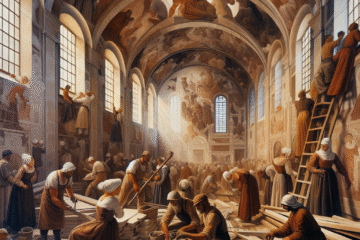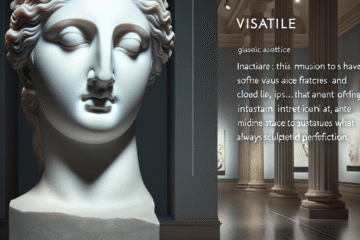Introduction: The Puzzle of the Spanish Court
Diego Velázquez’s 1656 masterpiece, Las Meninas, is often described as a visual enigma—a profound meditation on perception, authorship, and hierarchical power hidden within the canvas of a royal portrait. Created during Spain’s Golden Age, the painting transcends any traditional label of ‘portrait’ or ‘genre scene’; instead, it occupies a shifting threshold where viewer and subject trade places, where mirrors reflect more than light, and where illusion becomes a tool of artistic power.
In this article, we navigate the layered meaning of Las Meninas, contextualizing it within the evolving conventions of visual art, from Renaissance clarity to Baroque complexity and beyond. We explore how Velázquez turned a courtly image into a philosophical riddle—one that still captivates historians, philosophers, and artists alike.
1. Renaissance Vision: The Roots of Representation
To understand Velázquez’s innovation, we must first trace the development of representational art in the Renaissance. During the 15th and early 16th centuries, artists like Leonardo da Vinci and Raphael emphasized linear perspective and precise anatomical modeling, aiming to mirror the visible world through objective observation. The goal was mimetic accuracy—creating windows into another world through geometry and proportion, calibrated by the viewer’s eye.
This period also solidified the hierarchical nature of commissioned art. Paintings were typically didactic or devotional, modeling social or theological order. Royal portraiture, in particular, was tightly bound to representation of status—static, formal, and symbolic. Into this tradition entered Velázquez, who would come to redefine its very premises.
2. The Baroque Shift: Image and Reality Intertwined
By the 17th century, European art began embracing the dynamism and drama of the Baroque. Caravaggio, Rembrandt, and Rubens infused paintings with movement, shadow, and tension between surface and meaning. This was the world Velázquez inhabited—a court painter not only to King Philip IV, but to a culture increasingly aware of the subtle interplay between appearances and truth.
In Las Meninas, this Baroque consciousness permeates every layer. The scene appears to show a candid moment in the artist’s studio, with the young Infanta Margarita surrounded by her ladies-in-waiting, a court dwarf, a mastiff, and Velázquez himself standing before an enormous canvas. Yet nothing is quite as it seems. A distant mirror reflects the images of the king and queen—yet they do not visibly appear in the room. Are we seeing Velázquez painting them, or us, the viewers? This optical ambiguity initiates a dialogue about the act of looking and being looked at, a hallmark of Baroque theatricality.
3. The Mirror and the Eye: Perception as Power
The mirror at the back wall of Las Meninas is no mere compositional flourish; it’s a visual philosopher’s stone. Its reflection captures the monarchs seemingly positioned where the viewer stands—subtly proposing that the act of viewing is also an act of being observed. This self-referential device predates postmodern commentary by centuries, yet it operates with equal sophistication.
The inclusion of the artist himself, brush in hand, looking outward, casts Velázquez not merely as a craftsman but as an omniscient architect of perception. The mirror, thus, becomes both metaphor and mechanism. It destabilizes the hierarchy of subject and observer, elevating the painter from servant to sovereign of the frame. In a court where image equaled authority, such a move was audacious and deeply political.
4. Philosophical Echoes: Las Meninas and Modern Thought
It is no accident that centuries later, Michel Foucault would begin his seminal treatise The Order of Things with a meditation on Las Meninas. For Foucault, the painting served as an emblem of epistemic upheaval—a moment when the ways societies organized knowledge and visibility fundamentally shifted. In Velázquez’s canvas, the relations between the seen, the seer, and that which frames the experience are in constant flux.
More than a portrait, Las Meninas becomes an allegory of representation itself—how power is granted not only by who is painted but who controls the terms of the gaze. This echoes in today’s media landscape, where image manipulation and viewer positioning continue to shape political and cultural narratives.
5. Legacy and Digital Dialogues: The Painting in the Postmodern Age
The influence of Las Meninas stretches far beyond the Baroque. Artists such as Pablo Picasso created extensive reinterpretations—Picasso alone produced over 50 variations of the canvas in 1957—each dissecting the formal construction and psychological space of Velázquez’s original. Contemporary digital artists and curators revisit the painting as a meta-commentary on surveillance, authorship, and the mediated self.
In a digitized world, where screens are mirrors and selfies are self-constructed royal portraits, we are all performers in our own Meninas. Velázquez’s composition, with its layers of reality and illusion, thus reads as eerily prescient. It reminds us that art is not merely a passive reception of images but an ongoing choreography of viewers, frames, and reflective surfaces.
Conclusion: The Artist as Architect of Illusion
Las Meninas compels us because it resists conclusion. It is both self-portrait and royal commission, philosophical puzzle and cultural artifact. By balancing illusion and insight, Velázquez turned the canvas into a mirror—not just of the Spanish court, but of the mechanisms of vision itself. In doing so, he transformed the painter from a servant of the crown into a sovereign of perception. Four hundred years later, we are still standing before that canvas, still wondering—who sees whom?

Image description:
File:Las Meninas, by Diego Velázquez, from Prado in Google Earth.jpg
License:
Public domain
Source:
Wikimedia Commons


